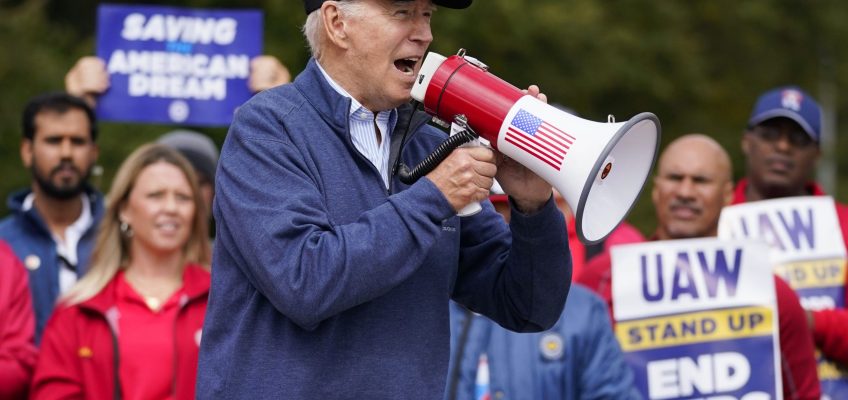The pieces are lining up for President Joe Biden to lay claim to a victory for his pro-union stance as the second of Detroit’s Big Three car companies reached a tentative agreement with the United Auto Workers on Saturday, according to two people familiar with the matter.
Stellantis notched the deal with the union following a final stretch of intense negotiations, merely days after the UAW similarly came to preliminary terms with Ford on a new four-year contract. General Motors is now the lone Detroit automaker still at the bargaining table and faces growing pressure to come to terms as its competitors’ workers return to their jobs pending ratification of their agreements.
Details of the Stellantis-UAW deal weren’t immediately available, but they are expected to closely follow Ford’s, given the union’s past practice of using its first agreement as a pattern for the other companies. Ford agreed to a 25 percent wage increase for workers across the course of the contract, along with other salary concessions.
Though the UAW members’ acceptance of the Ford and Stellantis deals is not yet assured, they are crucial steps toward ending a six-week disruption to the automotive industry and its supply chains that has cost billions of dollars.
Biden is now closer than ever to turning the page on a major concern as he begins navigating shared governance with new House Speaker Mike Johnson, just ahead of another deadline to fund the government. It eases the danger that unrest in the sprawling auto industry will be an economic drag as he makes his pitch for reelection.
The UAW called its Ford members back to work immediately after its deal was announced, and Saturday’s breakthrough will likely end the strike against Stellantis plants — whose product lines include Jeep, Ram Trucks, Dodge and Chrysler — in short order as well.
The strike began Sept. 15, with Ford and GM offering 20 percent pay increases — already up from the raises of 9 and 10 percent, respectively, that they initially proposed. The UAW also showed flexibility, moving off its original demand of 40 percent raises to mirror CEO pay growth in the last four years.
Both Democrats and Republicans have tried to use the strike’s political symbolism to their advantage.
Biden joined workers on the picket line in September, the first time in living memory a sitting president has done so. That came a day before former President Donald Trump traveled to Michigan to troll Biden and woo blue-collar votes.
But Biden has more tools at his disposal.
His administration has dispatched deputies to be a presence on the ground. White House senior adviser Gene Sperling and acting Labor Secretary Julie Su traveled to Detroit multiple times to meet with the parties, aid in the bargaining process and move negotiations forward, a Labor Department spokesperson said Thursday.
At the same time, the UAW has kept some distance between itself and the administration so as to not mire the ongoing negotiations in partisan politics — and potentially alienate some of its membership.


Leave a Reply